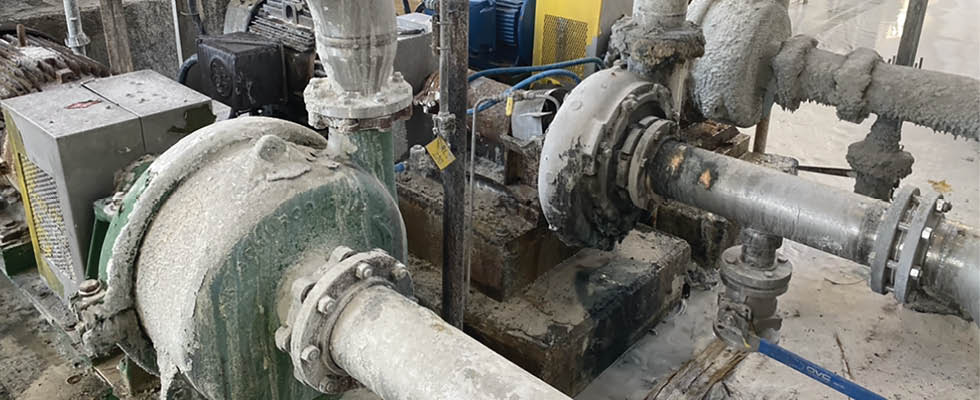
Since the 1980s, economic trends have been developing in the pulp and paper industry that have had major impacts on how mills must operate to survive in the 21st century. The industry now operates in a global market with foreign competition, so it must evolve with changing environmental regulations, remain competitive and supply products to users who demand higher quality products, all while cutting its cost per ton.
The pulp and paper industry has been a crucial part of society for generations, providing materials essential for communication, packaging, currency, etc. The industry has evolved, embracing new technologies to improve efficiency and productivity. The manufacturing processes involved in papermaking require the handling of various types of slurries, such as lime slurry, caustic, black liquor and white liquor.
In the pulp and paper industry, the main type of pump used to handle these slurries is American National Standards Institute (ANSI) centrifugal. This is the same type of pump used to handle clear water and pulp fiber slurry in the mill. The only difference in these units is the materials used in the construction of the impeller, casing, stuffing box and suction wear plates. The units handling slurries typically use a duplex stainless steel (SS) known as CD4MCu on these parts, while the units handling water and pulp fiber are typically 316 SS and ductile iron. The CD4MCu material has a 240 Brinell hardness and does offer extended wear versus 316 SS and ductile iron, but it is also expensive.
Slurry pumps have a long history and are commonly used in the power and sand and mining and gravel industries due to the need for handling both abrasive and corrosive slurries. Over the years, the advancement of materials and design efficiency in slurry pump technology has become crucial for maintaining efficient operations that help lower mining and power companies’ production costs.
For many years, slurry pumps were offered in chrome iron and natural rubber and were only used to pump neutral dirt or ore in the wet separation process in the mining industry. However, developments in materials have broadened the market for slurry pumps.
Various types of chrome materials are now used to handle materials with a potential of hydrogen (pH) of two and a variety type of acids. They are also available in elastomer products such as ethylene propylene diene monomer (EPDM), neoprene and butyl that can handle elevated temperatures and
corrosive liquids.
A slurry pump manufacturer recently visited a pulp and paper mill to discuss the use of slurry pumps versus ANSI process pumps. Slurry pumps are more robust and are designed to handle heavy abrasive and corrosive slurries that can dramatically increase the wear life and reliability of the pump installation. This can lead to cost savings by reducing the need for pump maintenance, spare parts and downtime.
How and why? First, a true centrifugal slurry pump is more robust than an ANSI centrifugal pump based on mass. For instance, a CD4MCu 6x4-13 ANSI unit weighs approximately 450 pounds (lbs). A chrome 6x4-13 slurry pump weighs 1,000 lbs. To break this down even further, the ANSI 13.0-inch impeller weighs approximately 20 lbs. A chrome slurry
13.0-inch impeller weighs 150 lbs. Therefore, the chrome slurry impeller will provide a longer wear life.
Second, technological advancements have allowed for the development of specialized slurry pumps, enabling paper mills to handle a broader range of slurries efficiently. Today, slurry pumps are available with numerous impeller styles, such as high-efficiency, large particle and open style for handling fibrous material and high-head applications.
Slurry pumps can play a pivotal role in various aspects of the papermaking process. They are extensively used for transporting different types of slurries within the mill, ensuring the continuous flow of materials between the different stages of paper production. Some of the key roles of slurry pumps in pulp and paper mills include:
Pumping lime slurry: Lime slurry plays a critical role in the papermaking process. It helps adjust the pH levels of pulp, thereby enhancing the bleaching process. Slurry pumps designed for handling lime slurries are equipped with abrasion-resistant materials, as lime slurries can be highly abrasive. These pumps efficiently transport the lime slurry to designated points, ensuring proper pH control and contributing to the production of high-quality paper.
Pumping caustic: Caustic solutions are vital for the pulping process, as they aid in breaking down lignin from wood fibers, making them suitable for papermaking. Slurry pumps used for handling caustic solutions are constructed with materials that are resistant to chemical corrosion. These pumps ensure the safe and efficient transfer of caustic solutions within the paper mill, optimizing the pulping process.
Pumping white and black liquors: White and black liquors are essential byproducts of the pulping process. White liquor is used for cooking wood chips, while black liquor contains valuable chemicals that can be recovered and recycled. Efficient pumping of these liquors ensures minimal waste and optimal resource utilization within the paper mill.
Slurry pumps have played a crucial role in pulp and paper mills, facilitating the transport of various slurries essential for the papermaking process. From handling lime slurry and caustic to pumping white and black liquor, slurry pumps are indispensable in ensuring smooth operations and high productivity. The future of slurry pumps in pulp and paper is promising, with advancements in materials and energy efficiency on the horizon. As technology continues to evolve, slurry pumps will remain a vital component in the ongoing success of the papermaking industry, helping mills lower their cost per ton and remain profitable.


